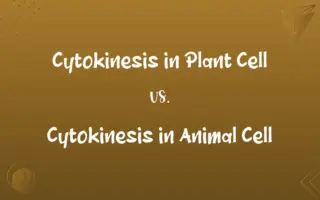Transpiration vs. Translocation: Know the Difference

By Shumaila Saeed || Published on February 3, 2024
Transpiration is the process of water vapor loss from plants, primarily through stomata, while translocation is the movement of nutrients and sugars within a plant, mainly through phloem.

Key Differences
Transpiration involves the evaporation of water from plant surfaces, especially through the leaves. It is a crucial process for plants as it facilitates the movement of water and nutrients from the roots to the leaves. On the other hand, translocation refers to the movement of sugars, produced in the leaves during photosynthesis, to other parts of the plant through the phloem. This process is essential for distributing energy throughout the plant.
Shumaila Saeed
Feb 03, 2024
The process of transpiration primarily occurs in the leaves, where water vapor exits the plant through microscopic pores called stomata. This loss of water vapor creates a negative pressure, aiding in the uptake of water and minerals from the roots. Translocation, however, involves the transport of organic compounds, particularly sucrose, which is transported from the leaves (the source) to various parts of the plant like stems, roots, and fruits (the sinks).
Shumaila Saeed
Feb 03, 2024
Transpiration has a significant role in regulating the temperature of the plant and maintaining the moisture balance in the environment. It is also involved in the water cycle, contributing to cloud formation and precipitation. Conversely, translocation is pivotal in the growth and development of a plant, supplying necessary nutrients to growing tissues, storing nutrients, and supporting reproductive structures like fruits and seeds.
Shumaila Saeed
Feb 03, 2024
Environmental factors such as temperature, humidity, and wind speed heavily influence transpiration rates. Higher temperatures and lower humidity can increase transpiration. Translocation, however, is less influenced by external environmental factors and more by the plant’s internal needs and energy status. The process is driven by osmotic pressure gradients between the source and sink regions.
Shumaila Saeed
Feb 03, 2024
In terms of biological mechanisms, transpiration is a passive process driven by environmental conditions and does not require energy from the plant. Translocation, in contrast, is an active process that requires energy (ATP) to transport sugars and nutrients against concentration gradients from sources to sinks within the plant.
Shumaila Saeed
Feb 03, 2024
ADVERTISEMENT
Comparison Chart
Primary Function
Evaporation of water from plant surfaces
Movement of nutrients and sugars within the plant
Shumaila Saeed
Feb 03, 2024
Main Occurrence Site
Leaves, through stomata
Throughout the plant, in phloem tissues
Shumaila Saeed
Feb 03, 2024
Role in Plant
Water and nutrient uptake, temperature regulation
Distribution of energy, growth, and development
Shumaila Saeed
Feb 03, 2024
Environmental Influence
Highly influenced by external factors like humidity
Primarily driven by plant's internal needs
Shumaila Saeed
Feb 03, 2024
Energy Requirement
Passive process, no energy required
Active process, requires energy (ATP)
Shumaila Saeed
Feb 03, 2024
ADVERTISEMENT
Transpiration and Translocation Definitions
Transpiration
The loss of water vapor from plant parts, especially leaves.
The transpiration from the leaves contributed to the plant's cooling.
Shumaila Saeed
Jan 19, 2024
Translocation
The movement of nutrients and sugars within a plant.
Translocation distributes sugars from the leaves to the growing fruits.
Shumaila Saeed
Jan 19, 2024
Transpiration
A mechanism for regulating water and nutrient transport in plants.
Through transpiration, plants maintain their water and nutrient balance.
Shumaila Saeed
Jan 19, 2024
Translocation
An active process requiring energy in plants.
The plant uses energy for the translocation of sugars from leaves to roots.
Shumaila Saeed
Jan 19, 2024
Transpiration
An essential part of the water cycle involving plants.
Transpiration plays a key role in returning water to the atmosphere.
Shumaila Saeed
Jan 19, 2024
ADVERTISEMENT
Transpiration
A process involving the movement of water within a plant and its subsequent evaporation.
Transpiration helps in transporting minerals from the soil to different plant parts.
Shumaila Saeed
Jan 19, 2024
Translocation
A transfer of a chromosomal segment to a new position, especially on a nonhomologous chromosome.
Shumaila Saeed
Jan 18, 2024
Transpiration
The act or process of transpiring, especially through the stomata of plant tissue or the pores of the skin.
Shumaila Saeed
Jan 18, 2024
Transpiration
(botany) The loss of water by evaporation in terrestrial plants, especially through the stomata; accompanied by a corresponding uptake from the roots.
Shumaila Saeed
Jan 18, 2024
Translocation
(Botany) The movement of sap downward and upward within the phloem, bringing nutrients to all living parts of a plant.
Shumaila Saeed
Jan 18, 2024
Transpiration
(physiology) The process of giving off water vapour through the skin or mucous membranes.
Shumaila Saeed
Jan 18, 2024
Translocation
Removal of things from one place to another; displacement; substitution of one thing for another.
Shumaila Saeed
Jan 18, 2024
Translocation
(genetics) A transfer of a chromosomal segment to a new position, especially on a nonhomologous chromosome; the segment so transferred.
Shumaila Saeed
Jan 18, 2024
Transpiration
The act or process of transpiring or excreting in the form of vapor; exhalation, as through the skin or other membranes of the body; as, pulmonary transpiration, or the excretion of aqueous vapor from the lungs. Perspiration is a form of transpiration.
Shumaila Saeed
Jan 18, 2024
Transpiration
The evaporation of water, or exhalation of aqueous vapor, from cells and masses of tissue.
Shumaila Saeed
Jan 18, 2024
Translocation
Removal of things from one place to another; substitution of one thing for another.
There happened certain translocations at the deluge.
Shumaila Saeed
Jan 18, 2024
Transpiration
The passing of gases through fine tubes, porous substances, or the like; as, transpiration through membranes.
Shumaila Saeed
Jan 18, 2024
Transpiration
The passage of gases through fine tubes because of differences in pressure or temperature
Shumaila Saeed
Jan 18, 2024
Translocation
(genetics) an exchange of chromosome parts;
Translocations can result in serious congenital disorders
Shumaila Saeed
Jan 18, 2024
Transpiration
The process of givng off or exhaling water vapor through the skin or mucous membranes
Shumaila Saeed
Jan 18, 2024
Translocation
A process in plants that transports photosynthates through the phloem.
Translocation ensures that all parts of the plant receive necessary nutrients.
Shumaila Saeed
Jan 19, 2024
Translocation
Essential for the growth and development of plant parts.
Translocation supports the development of new leaves and flowers.
Shumaila Saeed
Jan 19, 2024
Transpiration
A process influenced by environmental conditions like temperature and humidity.
High temperatures significantly increased the rate of transpiration in the plants.
Shumaila Saeed
Jan 19, 2024
Translocation
Influenced by the plant’s internal nutritional needs.
The rate of translocation varies depending on the plant’s growth stages.
Shumaila Saeed
Jan 19, 2024
Repeatedly Asked Queries
What does translocation refer to in botany?
The movement of nutrients and sugars within a plant, mainly through phloem.
Shumaila Saeed
Feb 03, 2024
Where does transpiration mainly occur in a plant?
Mostly in the leaves through stomata.
Shumaila Saeed
Feb 03, 2024
How is transpiration beneficial to plants?
It aids in nutrient and water uptake, and temperature regulation.
Shumaila Saeed
Feb 03, 2024
What is transported during translocation in plants?
Organic compounds like sugars and nutrients.
Shumaila Saeed
Feb 03, 2024
Does transpiration contribute to the water cycle?
Yes, it's a key component in the water cycle.
Shumaila Saeed
Feb 03, 2024
What role does translocation play in a plant's growth?
It supplies nutrients to growing parts, aiding in overall growth and development.
Shumaila Saeed
Feb 03, 2024
What is transpiration in plants?
The process of water vapor loss from plant parts, primarily leaves.
Shumaila Saeed
Feb 03, 2024
What drives the process of translocation?
Osmotic pressure gradients and the plant's energy (ATP).
Shumaila Saeed
Feb 03, 2024
Is transpiration affected by weather?
Yes, factors like temperature and humidity greatly influence it.
Shumaila Saeed
Feb 03, 2024
Can translocation occur at night?
Yes, as it is not directly influenced by sunlight.
Shumaila Saeed
Feb 03, 2024
Can transpiration occur through plant parts other than leaves?
Yes, but leaves are the primary site.
Shumaila Saeed
Feb 03, 2024
What is the main difference between transpiration and translocation?
Transpiration is water vapor loss, while translocation is the movement of nutrients and sugars.
Shumaila Saeed
Feb 03, 2024
How is translocation essential for fruit development?
It transports sugars to fruits, supporting their growth and maturation.
Shumaila Saeed
Feb 03, 2024
How does environmental temperature affect transpiration?
Higher temperatures generally increase transpiration rates.
Shumaila Saeed
Feb 03, 2024
Is transpiration visible to the naked eye?
Not directly, but its effects like leaf cooling can be observed.
Shumaila Saeed
Feb 03, 2024
What happens to a plant if transpiration is hindered?
It can lead to overheating and reduced nutrient transport.
Shumaila Saeed
Feb 03, 2024
Does translocation require energy?
Yes, it's an active process requiring ATP.
Shumaila Saeed
Feb 03, 2024
Are roots involved in translocation?
Yes, they can be recipients (sinks) of nutrients transported through translocation.
Shumaila Saeed
Feb 03, 2024
What regulates the rate of translocation in plants?
The plant's internal needs and energy status.
Shumaila Saeed
Feb 03, 2024
Share this page
Link for your blog / website
HTML
Link to share via messenger
About Author
Written by
Shumaila SaeedShumaila Saeed, an expert content creator with 6 years of experience, specializes in distilling complex topics into easily digestible comparisons, shining a light on the nuances that both inform and educate readers with clarity and accuracy.































































